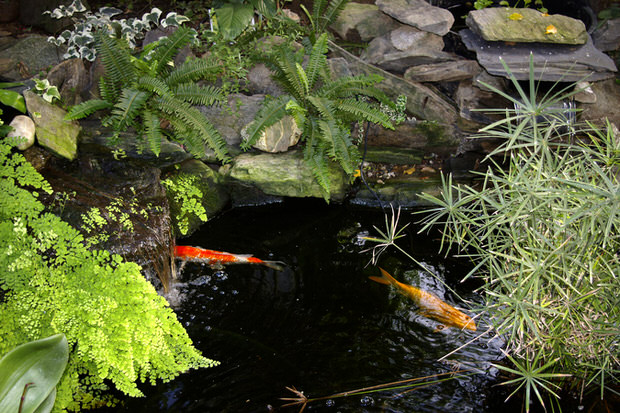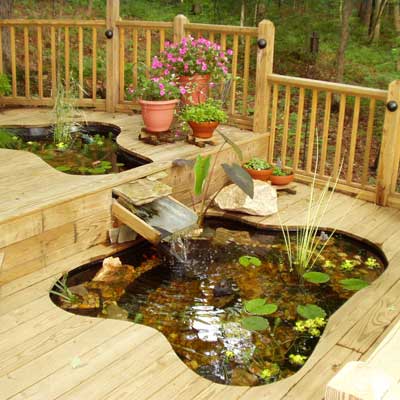






Why Choose A Garden Pond?
Do you enjoy spending time in your garden or outdoor space? Do you gain a sense of relaxation and well-being from the sound and feel of your natural surroundings? Do you enjoy the sound of birds singing, the rustle of plants in the wind, the hum of pollinating bees and the scent of flowers in full bloom?
Garden ponds can improve on that experience by adding a new dimension to any outdoor space – from bath tub-sized to a small lake, the benefits of a garden pond are potentially available to anyone with a little outdoor space.
Many people find the sight and sound of water to be relaxing, even therapeutic. An afternoon by a lake or river can provide the perfect antidote to the stresses and pressures of modern life.
With a garden pond, you can bring that experience back home, and recreate it in your own garden.
In addition, adding water to your garden offers a whole range of opportunities to extend and vary the ecosystem of your outdoor space and to create a more varied and rich environment right on your doorstep.
What Can I Do With A Garden Pond?
What can’t you do? Given sufficient space, you can even make your own private swimming or fishing pond. But for most people, a far more modestly-sized pond is enough to create a wonderful addition to their garden.
Here are a few ideas to get you started.
Decorative Garden Pond
By far the most popular type of pond is one that is purely decorative. Without too much effort, it is possible to create a healthy and sustainable pond, with a variety of attractive aquatic plants and perhaps a little animal life too.
Water lilies provide a practical and attractive way to help keep the water free of algae, and with a few carefully chosen plants and rocks around the edge of your pond, you will have an attractive addition to your garden.

Fish Ponds
Garden ponds have a strong association in many people’s minds with Carp, and formal Japanese gardens. While a true Japanese garden takes many years to develop, a healthy fish pond just takes a few weeks, and many people enjoy the lustrous colors and calming movements of pond fish.
It’s a hobby that just takes a little time each day, and feeding and tending to your fish pond can be a relaxing and therapeutic way to unwind in the evening after a day’s work.
Educational Garden Ponds
This is not really a category on its own, because any pond can serve as an educational aid for young children, but it is important enough to be worth highlighting. Not all schools have easy access to natural environments, and the miniature ecosystem that can be contained in a garden pond can be a wonderful and enjoyable educational tool for young children.
Tadpoles and frogs are always a favorite, and often seem to arrive in ponds all by themselves! Equally, older children will learn about the effects of sunlight on plants and water, and how it’s necessary to maintain a healthy balance between different types of plant and animal.
Garden ponds can be a great educational tool for children (and adults!) and if you have young children, you will undoubtedly find that they love the garden pond!
Garden Pond Design
The creation of a garden pond does not have to be prohibitively expensive, but it does require a little time, money and good planning.
Making sure you get the planning right and not cutting corners on the construction is the best way to end up with a healthy, easy to maintain, and attractive pond, so we’ve put together a few tips to help you design your pond.
Locating Your Pond
Before you do anything else, decide where you’d like to have your pond. Consider the following points:
* Aim for a location that gets plenty of sun, especially in more temperate climates
* Stay away from trees whose leaves might end up in the pond – consider which way the prevailing wind blows
* Make sure you choose a location that you will be able to see from your porch or patio – after all the effort you will want to be able to enjoy the sight of your work.
* Make sure you can run an electrical supply to the pond – most ponds will need a pump or filter of some sort – and you’ll need a water supply too.
Building Your Pond
For smaller ponds, you will have the choice of a rigid or flexible liner – a pre-formed rigid liner may be easier to install and appear the better choice, but you may struggle to find one in the right shape for your chosen location. They are also quite hard to get level when you install them.
A flexible liner, on the other hand, allows you to create a pond of almost any shape and size, but requires a little more care and effort to install successfully. You can also create a more natural look by filling the inside with soil and rocks that allow underwater plants to grow.
Ultimately what’s best for you will depend on your budget and location, but make sure you research your choices thoroughly, and don’t underestimate the challenge of installing a pond successfully. It’s worth considering paying a professional to do the job, once you are clear on your requirements.
Whatever you choose, make sure you take time to enjoy the end result and reap the rewards of your own private water garden.
Article By Elizabeth Jean for http://www.Garden-Fountains.com
Copyright © www.100flowers.win Botanic Garden All Rights Reserved